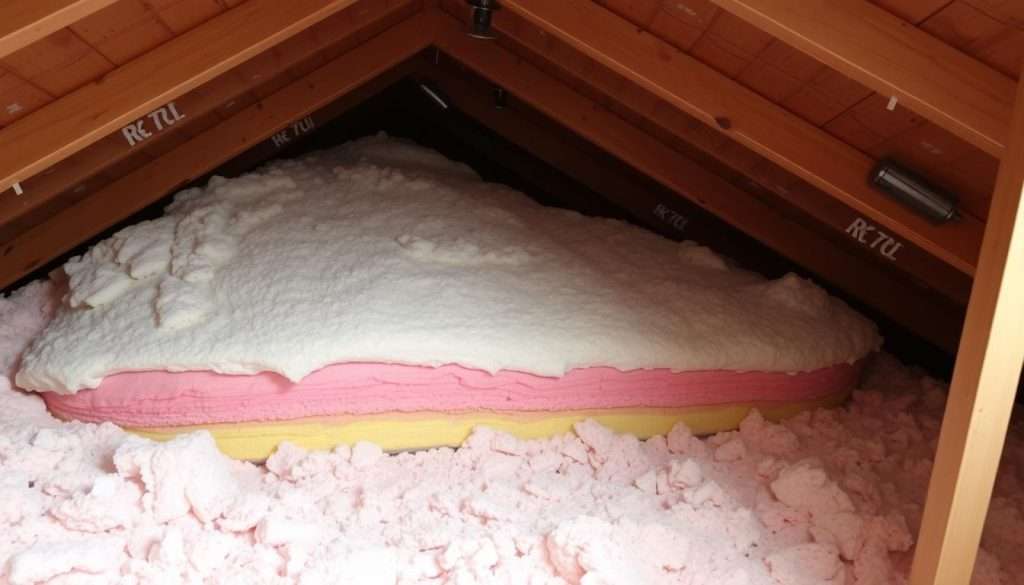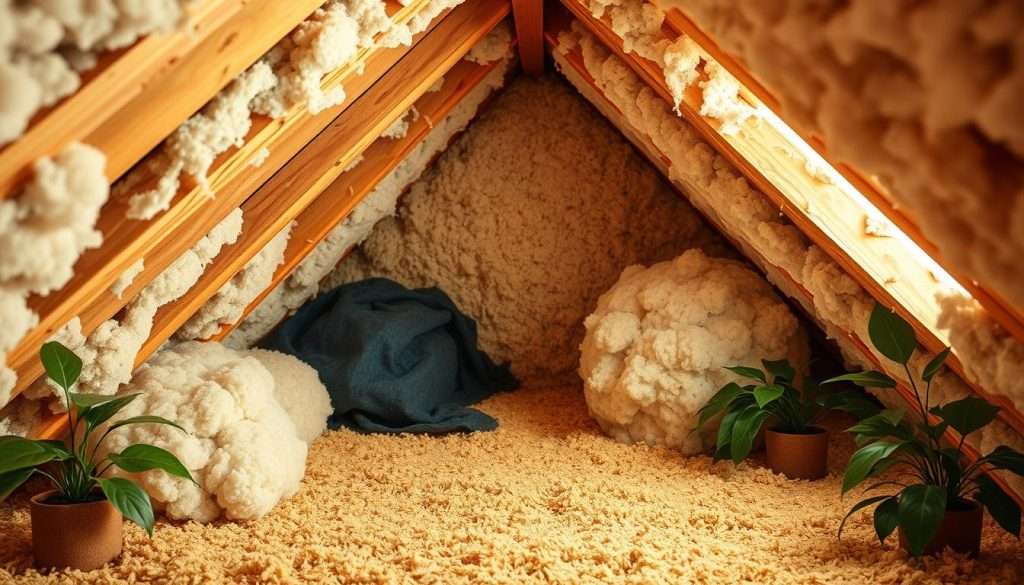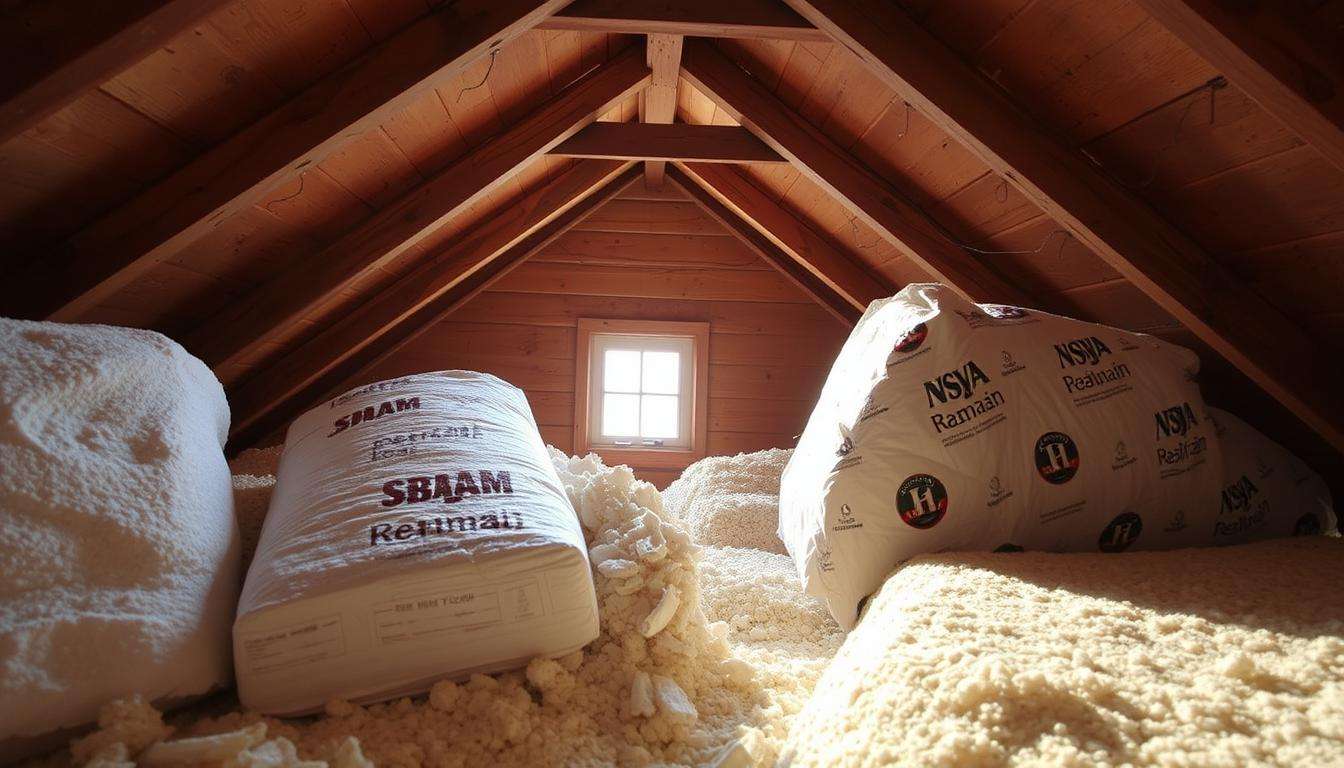Welcome to our guide on what kind of insulation for attic spaces! This guide is for DIY fans and new homeowners. We’ll help you pick the best insulation for your home.
We’ll talk about different insulation types, their R-values, and what to consider. By the end, you’ll know how to pick the best insulation for attics. You’ll make your home more energy-efficient and comfortable all year.
Key Takeaways
- Understand the different types of insulation for attics.
- Learn about R-values and why they matter.
- Evaluate climate, attic configuration, and budget when choosing insulation.
- Explore the pros and cons of DIY versus professional installation.
- Stay informed about local regulations and eco-friendly options.
Understanding Attic Insulation Basics
Knowing about attic insulation can make your home more energy-efficient. It helps keep your home at a good temperature all year. Whether you do it yourself or get help, knowing the basics is key.
What is Attic Insulation?
Attic insulation keeps your home warm in winter and cool in summer. It stops heat from moving from your attic to your living areas. Without it, your home might be too hot or too cold.
The right insulation can also save you money on energy bills.
Importance of Attic Insulation
Insulating your attic is very important. It makes your home use less energy. This can lead to:
- Lower energy bills
- A more comfortable home all year
- Longer life for your HVAC systems
Without enough insulation, you might spend more on energy. And your home might not feel as comfortable.
Common Insulation Terminology
Knowing insulation terms can help you make better choices. Here are some you should know:
| Term | Definition |
|---|---|
| R-Value | A measure of how well insulation keeps heat out. Higher R-values mean better insulation. |
| Batt Insulation | Ready-to-use fiberglass or mineral wool, easy to install. |
| Blown-In Insulation | Loose insulation like cellulose or fiberglass, blown in with a machine. |
| Thermal Bridging | When bad insulators let heat flow too fast, unlike the rest of the insulation. |
Types of Attic Insulation Available
Choosing the right attic insulation is key for keeping your home comfy and saving energy. There are many types, each with its own good points and downsides. Let’s look at the most common attic insulation options for homeowners.
Fiberglass Batt Insulation
Fiberglass batt insulation is popular because it’s cheap and easy to find. It has an R-value of R-2.2 to R-4.3 per inch. But, it might not work as well if it’s not put in right, because it can have gaps.
Because of this, it might not be the best for attics.
Blown-In Cellulose Insulation
Blown-in cellulose insulation comes from recycled paper, making it good for the planet. It has an R-value of R-3.1 to R-3.8 per inch. It fills gaps well, which is great for tricky spots.
People like it because it’s affordable and helps keep sounds down.
Spray Foam Insulation
Spray foam insulation has a high R-value, between R-6 and R-7 per inch. It seals air tight, which helps save energy. It’s pricier, but the long-term savings are worth it.
It needs a pro to install it right, for it to work well and safely.
Rock Wool Insulation
Rock wool insulation is made from natural or recycled stone. It’s good at keeping warm out and cool in, and it’s fire-resistant. It has an R-value of R-3.5 to R-4.5 per inch.
It’s a solid choice for safety and sound, and it works for new homes and updates.
R-Value: What You Need to Know
Knowing about R-value is key for good attic insulation. It shows how well insulation keeps heat out. This is important for comfort and saving energy at home.
Definition of R-Value
The R-value of insulation changes with its type, thickness, and density. Higher R-values mean better insulation. This helps control the climate inside.
But, radiant barriers and vapor barriers don’t have R-values. Knowing the average R-value per inch helps choose the right insulation.
Importance of R-Value in Performance
R-value affects how much energy you use and how comfy your home is. The right attic insulation keeps your home’s temperature steady. This saves money on heating and cooling.
Improving insulation can cut energy costs by up to 15%. The Department of Energy has charts for the right R-values for different parts of your home.
Recommended R-Values by Region
Where you live affects the needed R-values for attic insulation. The U.S. has eight climate zones with their own rules. Northern areas need R-49 or more, while the South might only need R-30 to R-38.
Think about insulation for walls, floors, and crawlspaces too. For example:
| Climate Zone | Recommended R-Value |
|---|---|
| 1-3 | R-30 to R-60 |
| 4 | R-38 |
| 5-8 | At least R-49 |
Good insulation saves energy and makes your home more valuable. Mixing insulation types or adding layers can help reach your R-value goal.

Factors Influencing Insulation Choice
Choosing the right insulation for your attic is key. It affects energy use, comfort, and costs. Climate, attic shape, and budget are important factors. Knowing these helps pick the best insulation for your home.
Climate Considerations
Your local weather affects insulation choice. In cold areas, use high R-value materials like spray foam. For warm places, pick materials that keep heat out. This keeps your home comfy without using too much energy.
Attic Configuration and Access
The attic’s shape and how easy it is to get to matters. Odd shapes or tight spots need materials like spray foam. It fits well in different spaces. Good coverage is key to keeping your home warm and saving energy.
Budget Considerations
Insulation costs include what you pay upfront and what you save later. Fiberglass is cheap, at $0.40 – $1.50 per square foot. Spray foam costs more, from $3 – $7 per square foot. But, some options like SIPs can save you money on electricity, cutting costs by 11%.
Benefits of Proper Attic Insulation
Proper attic insulation changes how we see home energy and comfort. It brings big benefits to homeowners who want better living spaces.
Energy Efficiency Improvements
Heating and cooling use a lot of energy, up to 60% in many homes. Good insulation helps use less of it. This makes your home more energy-efficient.
A well-insulated attic keeps air in and temperature steady. This makes your HVAC systems last longer. You’ll use less energy and save money.
Cost Savings on Energy Bills
Insulation can save a lot of money. The EPA says it can cut utility costs by 30%. A good attic insulation can pay for itself in a few years.
It keeps your home warm in winter and cool in summer. Plus, rebates from companies like Xcel Energy add to the savings.
Enhanced Comfort Levels
Attic insulation does more than save money. It makes your home more comfortable. It reduces noise, prevents pipes from freezing, and keeps your roof in good shape.
A well-insulated attic makes your home cozy. You can enjoy your home at a steady temperature all year.
| Benefit | Description | Potential Savings |
|---|---|---|
| Energy Efficiency | Reduces energy consumption by minimizing heating and cooling demands. | Up to 50% savings on energy costs |
| Cost Savings | Decreases utility bills by preventing heat loss and gain. | Average 30% on utility costs |
| Comfort Levels | Maintains stable indoor temperatures, reducing noise and preventing plumbing issues. | Improved overall comfort experience |
Installation Methods: DIY vs. Professional
Choosing between DIY insulation and hiring professionals is key for your home’s energy and comfort. Each option has its good and bad points. Homeowners need to think about these before deciding.
Pros and Cons of DIY Installation
DIY insulation can save you a lot of money. You can save hundreds or even thousands by not paying for labor. Fiberglass and mineral wool are good for DIY.
But, DIY has its downsides:
- Lack of expertise: Without experience, you might not insulate right, which can hurt energy efficiency.
- Time consumption: DIY projects often take longer than expected, causing delays.
- Safety risks: Handling materials wrong can be dangerous, especially with spray foam.
When to Hire a Professional
For complex insulation like spray foam, hiring a pro is best. Pros work faster than DIYers. They make sure your home is well-insulated and follows building codes.
They also offer warranties on materials and work. This gives homeowners extra peace of mind.
Cost Comparisons for Installation
Knowing the costs of attic insulation is important:
| Installation Method | Approximate Cost | Additional Considerations |
|---|---|---|
| DIY Insulation | $500 – $2,000 | Material costs only; potential risk of errors and inefficiency. |
| Professional Insulation | $1,500 – $5,000 | Includes labor; faster installation; warranty coverage; compliance with codes; insurance. |
In summary, DIY insulation might save money but has risks. It might not be as efficient as hiring pros. Think about your skills, budget, and needs to choose wisely.
Maintenance of Attic Insulation
Keeping your attic insulation in good shape is key for a cozy and energy-saving home. Regular checks can spot problems early. Knowing how to look for insulation damage helps you fix it fast. Here’s what you need to know.
Signs of Insulation Deterioration
Spotting insulation damage early saves money and keeps your home comfy. Watch for:
- Sagging or misshapen insulation
- Moisture buildup, which can lead to mold
- Big dust piles, meaning it might be time for new insulation
How to Inspect Your Insulation
Checking your insulation often is vital. Here’s how to do it:
- Make sure it’s safe to get into your attic.
- Look for gaps and damage in the insulation.
- Check for mold or pests.
- Make sure the insulation is spread out right and not squished.
By doing this, you can fix problems before they get worse.
Repair Options
If you find problems with your attic insulation, there are ways to fix it. It depends on what kind you have:
- Add new insulation where it’s needed.
- Seal air leaks to make it more efficient.
- Replace it all if it’s really damaged or settled.
These fixes not only make your insulation better but also save energy and money in the long run.
Local Regulations and Codes
When you work on your attic insulation, knowing local rules is key. Homeowners often forget how important these rules are. They help keep your home safe and working well. Make sure you know the attic insulation rules in your area before you start.
Building Code Requirements
Different places have their own rules for attic insulation. These rules include:
- Minimum R-value for insulation, which changes with the climate zone.
- Rules for stops and barriers to stop moisture.
- Rules for how materials in attic insulation breathe.
In California’s Zone 3, you need insulation with an R-value of 30 to 60. This shows how important it is to pick the right insulation for your area.
Permits Needed for Insulation Work
Before you start your insulation project, check if you need a permit. You might need one for:
- Adding new insulation to an old home.
- Big changes or new insulation during a big renovation.
- Using special insulation like spray foam.
Talking to local officials can help you avoid fines or extra work. Always make sure your insulation project follows the building codes for attic insulation.
| Aspect | Details |
|---|---|
| R-value Requirements | California Zone 3: R-value 30-60 |
| Moisture Control | Guidelines on vapor barriers and air sealing |
| Permits | Mandatory for major renovations or specialized insulation |
Environmental Considerations
In today’s world, picking insulation that’s good for the planet is key. Eco-friendly insulation helps your home use less energy and is better for the earth. This part talks about choices that are good for the environment and why they matter.
Eco-Friendly Insulation Options
Looking into sustainable insulation can show you materials that work well and are gentle on the earth. Some top picks include:
- Cellulose Insulation: Made from 82-85% recycled paper, it’s very effective and can last up to 30 years.
- Fiberglass Insulation: It’s made from 40-60% recycled glass and can last over a century.
- Cotton Insulation: It’s 85% recycled fibers, making it a great natural choice.
- Mineral Wool Insulation: It’s 75% recycled and also great for blocking sound.

Importance of Sustainability
Choosing eco-friendly insulation helps save energy and cuts down on carbon emissions. Buildings with good insulation can cut CO2 emissions by 780 million tons a year in the U.S. By picking sustainable insulation, you help the planet for the future. It also makes your home more comfortable and saves money in the long run.
| Insulation Type | Material Composition | Longevity |
|---|---|---|
| Cellulose | 82-85% Recycled Paper | Up to 30 Years |
| Fiberglass | 40-60% Recycled Glass | Up to 100 Years |
| Cotton | 85% Recycled Fibers | Up to 100 Years |
| Mineral Wool | 75% Recycled Materials | Up to 100 Years |
Using eco-friendly insulation in your attic makes your home more energy-efficient. It also supports green practices that help our planet.
Cost Estimates for Different Insulation Types
Knowing the cost of insulation is key for attic upgrades. Different types of insulation have different prices. This is based on materials and how they are installed. We will look at prices and what affects them.
Price Ranges by Insulation Type
Prices change based on the insulation type. Here’s a list of common types and their prices:
| Insulation Type | Cost Range (per sq. ft.) | Installation Considerations |
|---|---|---|
| Fiberglass Batt | $2 – $4 | Common choice, DIY-friendly |
| Blown-In Cellulose | $1 – $4 | Acts as an air barrier |
| Spray Foam | $2 – $5 | Higher efficiency, needs professional installation |
| Reflective | $0.50 – $1.50 | Best for hot climates |
| Structural Insulated Panels (SIPs) | $4 – $7 | Strong insulated walls and roofs |
Factors Influencing Cost
Several factors can change insulation costs. It’s important to think about these before upgrading:
- Material Choice: Fiberglass, cellulose, or spray foam greatly affects costs.
- Installation Method: Professional setups are more expensive than DIY.
- Attic Size: Bigger attics cost more because of more materials and work.
- Labor Costs: Contractors charge between $0.56 and $2.75 per square foot, impacting total costs.
- Additional Services: Costs for attic prep, cleaning, and checks can add up a lot.
By knowing these costs and factors, you can make smart choices for your attic insulation.
Conclusion: Making an Informed Choice
Let’s sum up our guide on attic insulation. Think about the R-value of different materials. This shows how well they stop heat flow.
Choose from fiberglass batt, eco-friendly cellulose, or spray foam insulation. Keep your budget and climate in mind. Also, decide if you want to install it yourself or hire a pro.
Recap of Key Points
Choosing the right insulation depends on several things. These include the type of material, cost, and climate. You also need to decide if you want to do it yourself or get professional help.
Each option has its own benefits. Fiberglass batt is affordable, while spray foam seals well. Thinking about these points helps you make a choice that’s both efficient and practical.
Final Tips for Homeowners
For the best results, talk to professionals for advice that fits your needs. Think about how much you’ll save in the long run when picking insulation. By using energy-saving methods and knowing your home’s needs, you can cut down on energy waste.
This also reduces drafts and keeps pests out. It makes your home more comfortable to live in.
